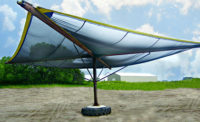The Best-Laid Plans
One of the benefits of attending the AAMP convention in Kansas City this year, apart from enjoying the smells and tastes of the Cured Meat Championships, was spending a couple of days in one of my favorite towns. As a former Kansas Jayhawk, I’ve always loved K.C.—its barbecue, its people, its beautiful major-league stadium with the minor-league team inside.
One morning, my family and I went out for breakfast at a national chain. I HOPe you don’t mind if I don’t mention its name. While we were waiting for our food, I felt a couple drops of water on my arm. I looked around and couldn’t find the source. A few minutes later, it happened again, and my wife looked up and noticed I was sitting directly under an air conditioning vent that was dripping condensation onto me and our table. It was then that I looked at the ceiling of the place for the first time and noticed all the ceiling tiles around all the vents had water damage.
A few years ago, I might have shrugged it off and shifted my chair. Now, having gone through enough meat plants and learned how and why companies try to eliminate condensation, I know better. After a few conversations with various waitresses, we found a new table that didn’t have potentially contaminated water dripping down on us and our food. Not five minutes later, our old table was filled by another family, one that had a baby with them.
Here’s what bothered me. This restaurant’s food suppliers, from the bacon and sausage processors to the juice and egg suppliers, struggle with food safety on a daily basis. They probably implement new food-safety measures regularly and spend thousands of dollars to test and verify that their products are safe. Then that food gets delivered to a restaurant where dirty water drips on it and puts all that effort to waste.
How frustrating it must be to work with someone who doesn’t understand food safety. A safe food supply only works if everyone, from the farmer who raises the animal down to the line cook who prepares the meal, is working toward the same goal.
If you’re in the meat-processing industry, at any level, then you have to be a food-safety authority. That knowledge that you’ve gained can’t just stay in your plant. It has to be shared with your retail and restaurant customers, so they know the best ways to store and prepare your products. As my experience shows, some customers need that education a little more than others.
Oh, and the next time you go into a restaurant to eat, check the ceiling for water damage before sitting down. Trust me.
Sam Gazdziak
gazdziaks@bnpmedia.com
Looking for a reprint of this article?
From high-res PDFs to custom plaques, order your copy today!





